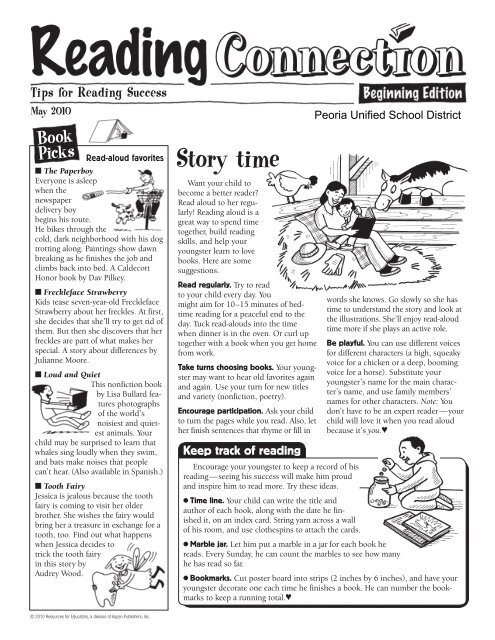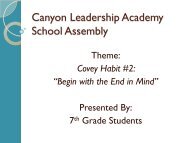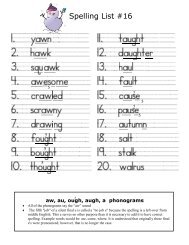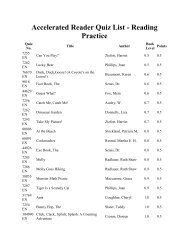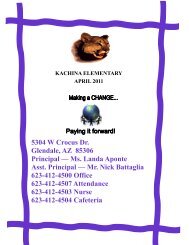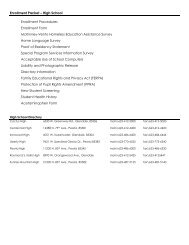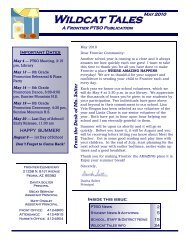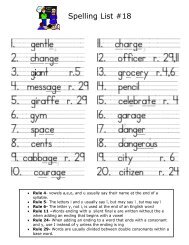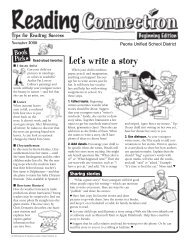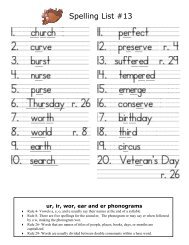5-10 Beginner English - Peoria Unified School District
5-10 Beginner English - Peoria Unified School District
5-10 Beginner English - Peoria Unified School District
Create successful ePaper yourself
Turn your PDF publications into a flip-book with our unique Google optimized e-Paper software.
<strong>Peoria</strong> <strong>Unified</strong> <strong>School</strong> <strong>District</strong>Read-aloud favorites■■The PaperboyEveryone is asleepwhen thenewspaperdelivery boybegins his route.He bikes through thecold, dark neighborhood with his dogtrotting along. Paintings show dawnbreaking as he finishes the job andclimbs back into bed. A CaldecottHonor book by Dav Pilkey.■■Freckleface StrawberryKids tease seven-year-old FrecklefaceStrawberry about her freckles. At first,she decides that she’ll try to get rid ofthem. But then she discovers that herfreckles are part of what makes herspecial. A story about differences byJulianne Moore.■■Loud and QuietThis nonfiction bookby Lisa Bullard featuresphotographsof the world’snoisiest and quietestanimals. Yourchild may be surprised to learn thatwhales sing loudly when they swim,and bats make noises that peoplecan’t hear. (Also available in Spanish.)■■Tooth FairyJessica is jealous because the toothfairy is coming to visit her olderbrother. She wishes the fairy wouldbring her a treasure in exchange for atooth, too. Find out what happenswhen Jessica decides totrick the tooth fairyin this story byAudrey Wood.Want your child tobecome a better reader?Read aloud to her regularly!Reading aloud is agreat way to spend timetogether, build readingskills, and help youryoungster learn to lovebooks. Here are somesuggestions.Read regularly. Try to readto your child every day. Youmight aim for <strong>10</strong>–15 minutes of bedtimereading for a peaceful end to theday. Tuck read-alouds into the timewhen dinner is in the oven. Or curl uptogether with a book when you get homefrom work.Take turns choosing books. Your youngstermay want to hear old favorites againand again. Use your turn for new titlesand variety (nonfiction, poetry).Encourage participation. Ask your childto turn the pages while you read. Also, lether finish sentences that rhyme or fill inKeep track of readingwEncourage your youngster to keep a record of hisreading—seeing his success will make him proudand inspire him to read more. Try these ideas.●●Time line. Your child can write the title andauthor of each book, along with the date he finishedit, on an index card. String yarn across a wallof his room, and use clothespins to attach the cards.words she knows. Go slowly so she hastime to understand the story and look atthe illustrations. She’ll enjoy read-aloudtime more if she plays an active role.Be playful. You can use different voicesfor different characters (a high, squeakyvoice for a chicken or a deep, boomingvoice for a horse). Substitute youryoungster’s name for the main character’sname, and use family members’names for other characters. Note: Youdon’t have to be an expert reader—yourchild will love it when you read aloudbecause it’s you.♥●●Marble jar. Let him put a marble in a jar for each book hereads. Every Sunday, he can count the marbles to see how manyhe has read so far.●●Bookmarks. Cut poster board into strips (2 inches by 6 inches), and have youryoungster decorate one each time he finishes a book. He can number the bookmarksto keep a running total.♥© 20<strong>10</strong> Resources for Educators, a division of Aspen Publishers, Inc.
When the weather warms up, considermoving the learning outdoors witha family walk. Your child can practiceobserving and writing with these ideas:1. Stroll around your neighborhood, orwalk through a nature trail. Have youryoungster take along a notebook so hecan record what catches his eye.2. Suggest that your child sketch pictures ofhow it feels outside (a sun to show it’s hot),what he hears (birds singing), or what he smells (abackyard grill for the scent of barbecue). Also, encourageO u rC + at = cat!Combine letters tobuild words in this cardgame. You’ll help your youngster becomefamiliar with common word endings.First, give your child 18 index cardsand ask her to write a different consonanton each (skip q, x, and z). Then, help herwrite these word endings on 18 othercards: ab, an, ap, at, ed, en, et, id, im, in,ip, it, og, on, ot, un, up, ut.Shuffle each set of cards separately,and put them facedown in two piles.Take turns drawing one card from eachpile and trying to combine them into aword (h + og = hog). If a player can’tform a word (h + et), she keeps them inher hand. On the rest of her turns, shecan combine a new card with onealready in her hand.Keep going until every card has beendrawn. How many words can each personmake?♥P u r p o s eTo provide busy parents with practical waysto promote their children’s reading, writing,and language skills.Resources for Educators,a division of Aspen Publishers, Inc.128 N. Royal Avenue • Front Royal, VA 22630540-636-4280 • rfecustomer@wolterskluwer.comwww.rfeonline.comISSN 1540-5648© 20<strong>10</strong> Resources for Educators, a division of Aspen Publishers, Inc.A growing vocabularyHow can I keep mydaughter’s vocabulary strong while school’sout?Tell your daughterthat you and she will beon a “word hunt” thissummer. Suggest thatshe search for newwords everywhere. Shemight find them onclothing labels (cotton),at an amusement park(admission), or in stores(clearance). Remind herto listen for new words,him to draw interestingthings he sees. Hemight notice flowerspeeking throughrocks or spot ananimal-shapedcloud.3. At home, let youryoungster use hispictures to write astory about yourwalk. He can use hisdrawings and notes toadd details. Examples:“We saw a poodle in theclouds.” “I found yellow flowers next to rocks.” Let him dictateto you, write the words he knows, or write the wholestory. When he’s finished, you can read his story together.♥Put on a playWhen our son Nathanwas in the school play, it was all he couldtalk about. He wanted to put on shows athome, so I asked his teacher for ideas.Mrs. Frye said we could turn almostany story into a play. She recommendedthat we choose a book with just a fewcharacters. Each family member could pick apart and memorize that character’s lines. She said my husband or I could be thenarrator and read the rest of the story. For more fun, Mrs. Frye suggested that wemake masks. We drew characters’ faces on paper plates and glued on craft sticksto hold them.Nathan chose George and Martha by James Marshall and played George. Weused our masks and added props—a bowl, a pair of shoes, and a mirror. Nathanhad so much fun, he’s already planning our next show!♥too. She could hear them in songs (distant)or on the news (humidity).Tell each other every time yousee or hear a word you don’t know.You might jot them in a notebookso you can look them uptogether in the dictionarywhen you get home.Also, try to use the newwords frequently in conversation(“This skirt is made ofcotton”). You will help yourchild remember the words, andshe’ll go back to school in thefall with a bigger vocabulary.♥


